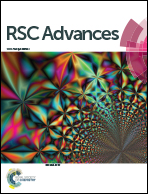Improvement of the resistance performance of carbon/cyanate ester composites during vacuum electron radiation by reduced graphene oxide modified TiO2†
Abstract
Electron irradiation in outer space causes severe damage to the polymer materials of spacecrafts. An effective approach to prevent such damage is to incorporate nanoparticles into the polymeric materials. Herein, we fabricated modified cyanate ester (CE) and carbon/CE composites by the incorporation of reduced graphene oxide–TiO2 (rGO–TiO2) nanoparticles and studied their resistance performance to electronic radiation. Compared with the carbon/TiO2/CE composite, the interlayer shear strength of the resulting carbon/rGO–TiO2/CE composite increased by 10.4% and its mass loss reduced by 16.5%. Scanning electron microcopy (SEM) images showed that there are more cracks at the fiber and resin interfaces of carbon/CE than at the interfaces of carbon/rGO–TiO2/CE after irradiation. X-ray photoelectron spectroscopy (XPS) investigation showed that irradiation with 160 keV electrons could break the chemical bonds at the surface layer of the pristine CE resin, which is effectively prevented by the incorporation of rGO–TiO2 nanoparticles.


 Please wait while we load your content...
Please wait while we load your content...